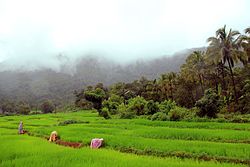| This article needs additional citations for verification. Please help improve this article by adding citations to reliable sources. Unsourced material may be challenged and removed. Find sources: "Netravali Wildlife Sanctuary" – news · newspapers · books · scholar · JSTOR (May 2020) (Learn how and when to remove this message) |

Netravali Wildlife Sanctuary is located in South-Eastern Goa, India. It constitutes one of the vital corridors of the Western Ghats and covers an area of about 211km. Netravali or Neturli is an important tributary of River Zuari, which originates in the sanctuary. Forests mostly consist of moist deciduous vegetation interspersed with evergreen and semi-evergreen habitat; there are also two all-season waterfalls in the sanctuary.
Location
Netravali Wildlife Sanctuary is located in Verlem, in the Sanguem Taluka region of South-Eastern Goa, around 65km from Goa Airport. It is adjacent to Dandeli-Anshi Tiger Reserve, Karnataka on the eastern side, Cotigao Wildlife Sanctuary, Goa on the southern side and Bhagwan Mahaveer Sanctuary and Mollem National Park on the northern side which in turn forms a contiguous protected area along with Madei Wildlife Sanctuary, Goa and Bhimgad Wildlife Sanctuary, Karnataka.
Flora and fauna
The sanctuary sustains a good mammal population due to its rich habitat and plenty of perennial streams. Gaur or Indian Bison (Bos gaurus), Malabar giant squirrel (Ratufa indica), four-horned antelope or chousingha (Tetracerus quadricornis), leopard (Panthera pardus), black sloth bear along with a host of other predators and herbivores find home in the sanctuary. Birds like the rare Malayan night heron (Gorsachius melanolophus), Nilgiri wood pigeon (Columba elphinstonii), great pied hornbill (Buceros bicornis), grey-headed bulbul (Pycnonotus priocephalus), white-bellied blue flycatcher (Cyornis pallipes), Wynaad laughingthrush (Garrulax delesserti), white-bellied treepie (Dendrocitta leucogastra), rufous babbler (Turdoides subrufa) have been sighted many times in the sanctuary. The sanctuary is a host for many rare butterfly species including the Malabar banded swallowtail (Papilio liomedon), Malabar banded peacock (Papilio buddha), Malabar tree nymph (Idea malabarica), southern birdwing (Troides minos), blue nawab (Polyura schreiber), black rajah (Charaxes solon) and redspot duke (Dophla evelina).
The sanctuary also hosts remnants of ancient forests featuring the distinctive Myristica swamp ecosystem, which dates back over 100 million years.
References
- ^ "Netravali Wildlife Sanctuary - 2020 All You Need to Know BEFORE You Go (with Photos)". Tripadvisor. Retrieved 8 May 2020.
- ^ Deshpande, Abhijeet. "Netravali Wildlife Sanctuary". Times of India Travel. Retrieved 8 May 2020.
- "Indian Tourism - Netravali Wildlife Sanctuary". www.indianmirror.com. Retrieved 8 May 2020.
- ^ "Netravali Wildlife Sanctuary". WildTrails Recent Sightings | The One-Stop Destination for all your Wildlife Travels. 23 September 2017. Retrieved 8 May 2020.
- "Handbook of the Birds of the World Alive | HBW Alive". www.hbw.com. Retrieved 8 May 2020.
- Goa Forest Department, Goa State, India.
- "Goa: 100-million-year-old Jurassic forests thrive in Sanguem". The Times of India. ISSN 0971-8257. Retrieved 14 December 2024.
| History | |||||||
|---|---|---|---|---|---|---|---|
| Government | |||||||
| Geography | |||||||
| Districts | |||||||
| Talukas | |||||||
| Cities | |||||||
| Heritage sites | |||||||
| Wildlife sanctuaries | |||||||
| Education | |||||||
| Science | |||||||
| Culture | |||||||
| Sports |
| ||||||
| Transport | |||||||